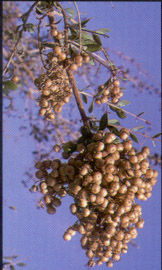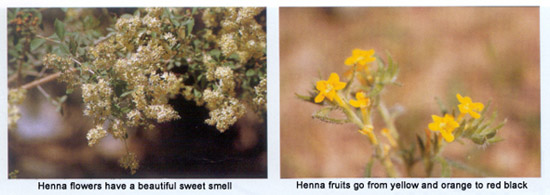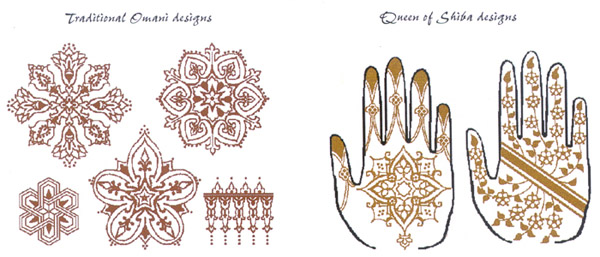We
were making our way down a flowing wadi at
the edge of a large plantation. Water
rushed over big boulders, giant red
dragonflies skitted across the surface of
stagnant pools along the banks, a bulbul
could be heard singing its melodious song
from within the palm grove. The sky was as
brightly blue as it can only get in Arabia
in the cool season.
A wonderful scent caught my attention; it
was an old-fashioned scent, very
"floral" and sweet.
"Mignonette" - I learned later.
The tree that carried the sweet-smelling
blossoms grew to a height of about 4
meters, looking a bit straggly with fine
branches and small leaves. The blossoms
were grouped in small clusters and were
white in colour. I realised I was looking
at the henna tree, whose scientific name
is Lawsonia inermis. It is a shrubby tree, the only species in the
Loosestrife or Lythraceae
family. It is also commonly called
“Egyptian privet” or “mignonette
tree”. It is well suited to survive a
harsh dry climate as long as it receives
regular water. A perfume is isolated from
the flowers, which is used as the base for
many local scents.
Wherever in the world men and women have
interacted, they have always tried to find
ways in which to make themselves more
attractive to the opposite sex. Women have
discovered cosmetics, using coloured dyes
or pastes to enhance their natural colours
or accentuate their features. In this way
the magenta dyes in the roots of the
Arabian primrose (Arnebia
hispidissima) were used as rouge, and
the black colour of charcoal made from the
roots of the "eyelash plant" (Blepharis ciliaris) was used in a paste with antimone to outline the
eyes as well as treat inflammations of the
eye. In North Africa, the indigo dye in
the indigo plant was used to colour skin
as well as textiles. In northern Oman even
men used to dye their beards with henna.
The use of the juices of the henna plant
to dye hair and nails was discovered some
5000 years ago in Egypt. From there the
practice spread over most of North Africa
and the Middle East, and was brought to
India with the spread of Islam. The henna
tree is considered to be one of the
"plants of Paradise" (shajarat
al jinna) and it was forbidden to
damage or cut down a tree or use its wood
as fuel.
 The fresh leaves and twigs of the plant
were ground into a fine powder and then
mixed with lemon juice and various herbs
to form a dark brown paste. This paste had
a cooling effect and was originally just
used to paint the soles of feet and the
tips of the fingers. Many medicinal powers
were ascribed to henna, from the treatment
of bee-stings, burns and boils to that of
headaches, hysteria and tumors. It was
claimed to have positive effects in
smallpox and leprosy, in jaundice and
venereal disease, and was used as a
deodorant, an aphrodisiac and an
astringent.
The fresh leaves and twigs of the plant
were ground into a fine powder and then
mixed with lemon juice and various herbs
to form a dark brown paste. This paste had
a cooling effect and was originally just
used to paint the soles of feet and the
tips of the fingers. Many medicinal powers
were ascribed to henna, from the treatment
of bee-stings, burns and boils to that of
headaches, hysteria and tumors. It was
claimed to have positive effects in
smallpox and leprosy, in jaundice and
venereal disease, and was used as a
deodorant, an aphrodisiac and an
astringent.
North African Berbers believed that henna
protects, brings luck and wealth, wards
off the evil eye and guards against black
magic and harmful genies.
This rather varied list of treatments
tells us more about the lack of remedies
in the past than about the true worth of
henna.
Nowadays henna is still known as a
medicine for a variety of ailments, but it
is best known for its use in the
application of intricate henna drawings to
the skin, resulting in pretty decorations
that last for many days. The active
component of the henna, that causes the
dye to penetrate the skin, is a chemical
called hennotannic acid. The design
remains until new skin cells have grown to
replace the old coloured ones.
Henna art is also called the art of
Mehendi. The designs that are applied to
hands and feet vary from region to region.
Whereas the Africans have bold geometric
shapes and favour the very dark colours,
the Arabs prefer large floral patterns and
a more reddish shade of the design. In
India the henna patterns are very lacey,
with paisley like designs. Over the years
the tools to apply henna have evolved so
that the designs could become more
intricate and additives to the henna paste
make the dye more intensely coloured and
glossy.
The henna designs are particularly
intricate and extensive when they are
applied on the occasion of a wedding. In
one region the women who apply the henna
incorporate the name of the bridegroom
somewhere in the design. If the groom, on
the wedding night, can find his name, this
is deemed a propitious sign.
Another tradition allows for the bride to
be excused from any housework as long as
her wedding henna is still visible on her
body. Having the henna applied to her also
teaches the bride patience, for it takes
many hours to apply the designs and then
another many hours for the henna to dry.

The henna paste is made from finely ground
fresh leaves (one part) mixed with two
parts of lemon or lime juice that has been
boiled with whole cloves or cardamom, and
1/2 part of sugar. Some oil, such as
eucalyptus oil, is often added to allow
the smooth flow of the henna from the
application tool. Sometimes in the case of
bridal henna, rose water or orange blossom
water is added as well. Different types of
henna release the dye at different times.
For instance, Moroccan henna has to be
used as soon as it is made; others have to
be prepared the day before they are used
to have a proper effect. After the design
is finished a fixative is used: one
teaspoon of sugar in two teaspoons of
lemon juice. Then the decorated skin is
covered overnight (saran wrap can be used)
in order to let the henna dry and the dye
penetrate into the skin. In the morning
the paste is wiped off the skin and the
brow-red design becomes clearly visible.
The
application of henna is part of the
culture of the Middle East. Particularly
prominent at weddings, henna is also used
for other celebrations such as the Eids.
Henna art has spread to the West and is
very popular among some groups of people
in Europe and the USA. On the internet one
can even find photo galleries of henna
designs as well as extensive information
about the use of henna as a cosmetic and a
medicinal herb. Recent medical research
has proved that henna extracts show
antibacterial, anti-fungal and UV light
screening activity.
Besides
that the shrub is popular in gardens
because of its white or pink blossoms, its
cluster of red and orange fruits and
especially its lingering sweet smell.

|
